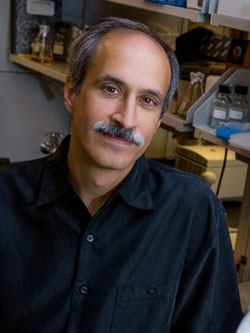Brown Prize goes to biochemistry professor based on alumni votes
Yousif Shamoo knows there’s nothing flashy or trendy about his Biochemistry I and Biochemistry II courses. They are large lecture classes. The material is dense, and there’s lots of it.
“It’s an old-fashioned class,” Shamoo said. “I do everything wrong. I use PowerPoint. I talk. They listen. And yet, somehow it seems to work.”
Rice alumni couldn’t agree more. Based on their votes, Shamoo will receive Rice’s highest teaching award, the George R. Brown Prize for Teaching Excellence, at the university’s annual teaching awards ceremony April 28 from 3 to 5 p.m. in Duncan Hall’s McMurtry Auditorium.
Shamoo, professor of biosciences and vice provost for research, has won three George R. Brown Awards for Superior Teaching since 2009, but this is the first time he’s won the Brown Prize. Both the Brown Awards and the Brown Prize are given based upon surveys of Rice alumni who graduated two, three and five years ago.
Shamoo credits much of his teaching success to his students and to his mentor and course co-instructor John Olson, the Ralph and Dorothy Looney Professor of Biosciences.
Olson, who’s also a three-time George R. Brown Award winner, said Shamoo’s sense of humor and gift for making the complex understandable have a great deal to do with his success.
“If you attend his lectures, you will not be looking at your watch and wondering how much longer until the class is over,” Olson said. “Yousif can make the most complicated biochemical process understandable and relevant, and he mixes humor with serious discussions in almost every lecture. For example, he might mention characters from ‘South Park,’ poisons used by the KGB, serious genetic disorders and the evolution of bacterial resistance to antibiotics.”
Olson said Shamoo also brings a bit of theater to the classroom. For example, to give students a real-life illustration of how hemoglobin is broken down by the body, Shamoo asks a student to hit his arm hard enough to cause a bruise, which then becomes a teaching aid. By following the color changes associated with bruising, the students learn about the release of hemoglobin from the damaged red cells and capillaries (red), hemoglobin oxidation (brown), release of free heme (green) and the breakdown of heme to bilirubin (yellow).
Shamoo credits Olson with helping him learn how to teach the course. “I came to Rice as an assistant professor, and I learned the ropes from him. He had taught this for many, many, years and he’s a great teacher. I think he’s been instrumental in having me love the course for what it is and stay in it.”
Biochemistry I (BIOC 301) is offered each fall and Biochemistry II (BIOC 302) each spring. They are a rite of passage for a Rice student who intends to go to medical school or graduate school in the life sciences. Shamoo and Olson share the teaching load, and Shamoo said the amount of material that must be covered makes the courses particularly challenging.
“There’s a lot to know, a huge amount to know, before you can even answer the questions,” Shamoo said. And solving problems based on the material is expected.
“Rice students are really good at knowing how to take up information, and they are really good at knowing how to take tests,” Shamoo said. “If they know everything I tell them in class, they’ll probably get around a 60 on the test. The rest of the points come from knowing how to synthesize new knowledge from the material they’ve learned.
“That’s the challenge,” he said. “Science and medicine are not true-false, multiple-choice disciplines. You will get information that’s partially true, incomplete and sometimes completely wrong, all presented together, and you have to figure out what the right answer is — the best course of action.”
Shamoo’s dedication to teaching the intro biochemistry courses stems partly from the fact that he is a biochemist and partly from his desire to prepare his students for postgraduate studies. “To me, as a biochemist, this is ‘The Course.’ It’s the chemistry of life, right?
“This is important stuff, and if they are going to go out there and be doctors, I want to make sure they know this,” he said.
Olson said, “Yousif does not ‘water down’ anything. When the students complete his sections, they have a strong sense of accomplishment and are certain that they have developed problem-solving skills that will serve them well in their graduate careers in research, medicine or engineering.”
Shamoo, who joined Rice’s faculty in 1998, said it’s not unusual for former students to email him about how they are doing in graduate school, and he’s recently run into former students who have finished their residency and are now practicing medicine in Houston.
“They usually tell me they crushed their biochemistry class in med school,” he said. “That’s because it’s a re-hash course in medical school. You’re just expected to know it, and it’s taught at double speed as a refresher course. Our course is much harder.”
Shamoo said he believes that that preparation is what makes students grateful, despite the “torture.”
“The students go off and become alumni, and they think, ‘I took that course from Shamoo and Olson. They really tried hard, and that material was really difficult,'” he said. “The funniest comments we get are the ones like, ‘Shamoo and Olson do the best they can with the material.’
“I guess that’s a compliment, right?”



Leave a Reply